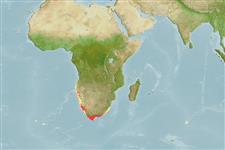Environment: milieu / climate zone / depth range / distribution range
Ecology
Marine; demersal; depth range 10 - 300 m (Ref. 27121). Subtropical
Southeast Atlantic: Namibia to Pondoland in Transkei, South Africa.
Size / Weight / Age
Maturity: Lm ? range ? - ? cm
Max length : 76.0 cm TL male/unsexed; (Ref. 6626); common length : 30.0 cm TL male/unsexed; (Ref. 9602)
Inhabits soft bottoms (Ref. 9602). Flesh edible, but not utilized commercially (Ref. 9602). Minimum depth reported from Ref. 6626.
Life cycle and mating behavior
Maturity | Reproduction | Spawning | Eggs | Fecundity | Larvae
Poss, S.G., 1986. Congiopodidae. p. 480-481. In M.M. Smith and P.C. Heemstra (eds.) Smiths' sea fishes. Springer-Verlag, Berlin. (Ref. 6626)
IUCN Red List Status (Ref. 130435: Version 2025-1)
Threat to humans
Harmless
Human uses
Fisheries: subsistence fisheries
Tools
Special reports
Download XML
Internet sources
Estimates based on models
Preferred temperature (Ref.
123201): 11.9 - 18.8, mean 14.4 °C (based on 35 cells).
Phylogenetic diversity index (Ref.
82804): PD
50 = 0.5312 [Uniqueness, from 0.5 = low to 2.0 = high].
Bayesian length-weight: a=0.01122 (0.00514 - 0.02450), b=3.04 (2.87 - 3.21), in cm total length, based on all LWR estimates for this body shape (Ref.
93245).
Trophic level (Ref.
69278): 3.4 ±0.58 se; based on food items.
Fishing Vulnerability (Ref.
59153): Moderate to high vulnerability (50 of 100).
🛈
